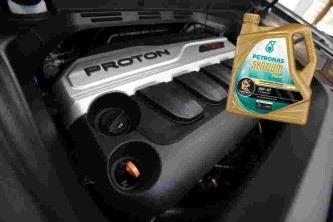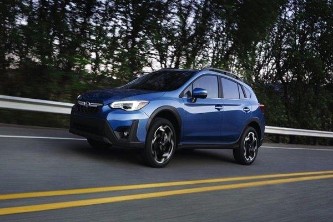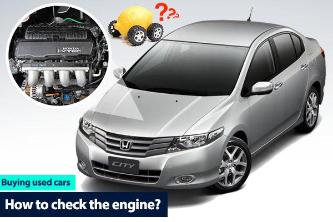engine lm2500
Artikel Terkait engine lm2500

Rumour: 2020 Proton X50 could get 1.4-litre engine option?
units have reportedly arrived in Malaysia.Codenamed JLB-4G14T, the 1.4-litre turbocharged four-cylinder engine
2021 Nissan X-Trail engine details revealed
fuel efficiency, based on a leaked internal corporate document.It looks like the current 2.5-litre engine
Mitsubishi Xpander’s 1.5L MIVEC engine, is it powerful enough?
Rush.Like its core rivals, the upcoming Mitsubishi Xpander is powered by a 1.5-litre four-cylinder engine
What's so special about the Isuzu D-Max's new 1.9L turbodiesel engine?
covers off the updated Isuzu D-Max, now equipped with the company’s new 1.9-litre turbodiesel engine
2019 Mazda CX-5, 2.0L, 2.5T, 2.2D, which engine to pick?
(Model | Gallery)The 2019 Mazda CX-5 boasts the most engine choices for any SUV sold in Malaysia.
New Lotus entry model will be their last combustion engine car
the most focused driver’s cars—says that they will be moving on from internal combustion engine
Engine braking is good for you, but how do you use it?
A: Using the engine to slow the car down.Just lift your foot off the acceleratorQ: How do you do engine
Should you buy engine oils from hypermarkets?
One of the very prevalent questions I get all the time on car maintenance, is about engine oils.
Honda Civic 1.5T: the perfect combination of engine and gearbox
vision of the Honda Civic was not affected by the low sitting position.The Honda Civic 1.5L turbocharged engine
All-new 2020 Nissan Almera to get turbocharged engine in Malaysia!
familiar with the matter, the Malaysian-spec, all-new 2020 Nissan Almera will be fitted with the same engine
Top-3 most powerful cars with a 3-cylinder engine
among the top reasons, but what if they decide to extract every bit of performance from a 3-cylinder engine
Let's take a look at Mazda’s electrified rotary engine, launching in 2022
What you see here, is a photo of Mazda’s upcoming rotary engine, mentioned alongside Mazda&rsquo
Engine mounting: 3 symptoms of bad engine mounts
Holding the engine in place and absorbing most of the engines vibration are engine mounts.
Rendered: 2021 Proton X70 MC1 facelift expected, 1.5 TGDI engine?
With the Proton X50 powered by a 1.5-litre TGDI engine and assembled in Malaysia, there is speculation
Is synthetic engine oil bad for older cars?
Besides the viscosity rating of engine oil, we also have the choice of what type of oil we’d like
Should you clean your engine bay?
If left attended for a long time, the engine bay can get rather unpleasant.
Mazda quietly released a new rotary engine when nobody was paying attention
Felix Wankel’s rotary engine design.
Mazda service centers switches to Petronas Syntium engine oil
with Petronas Lubricants Marketing Malaysia (PLMM) for the supply of Petronas Syntium full-synthetic engine
Honda City 1.0L Turbo, engine review: Should Malaysians demand for this new engine?
itself is not new to us.Back in 2015, yours truly have already sampled the same engine at a closed course
Mobil has a new engine oil that will protect your turbocharged engines
The new engine oil will join the existing Mobil Super 1000 and 2000 range in the market.
Review Post engine lm2500
Last minute preparations before we bring the engine to Innovate Arnhem. #VBRturbinepartners #VBR #LM2500 #Fieldbit #Innovate #Augmentedreality #AR #IOT #Fieldservice #InnovateArnhem #kleefsewaard https://t.co/owtyrSpIEd
Next meeting of the #Engine specific #User group for the LM2500 #GasTurbine is taking place on 14 & 15 June in Brussels. #Energy #Technology https://t.co/cQtPyg7oeF
Shivalik class frigates uses CODOG propulsion setup(Pic1). It uses GE LM2500+ GT(Pic2) with a reduction gear box(Pic3). Output of reduction gearbox & diesel engine feeds on to the main gearbox(Pic4) which goes to the propeller. This set up is repeated to get a set of 2 propellers https://t.co/29cw1GbfUS
The engines that HAL license builds in India. GE LM2500 marine engine is the latest addition to the list. HAL started building them a few years back. The Navy in the uprated version of the engine (LM2500+) in the Shivalik, Nilgiri class frigates & the upcoming INS Vikrant. https://t.co/lS1b5izaOQ
NEWS: GE celebrates the U.S. Navy, Bath Iron Works & other partners who helped design, develop and manufacture a new composite LM2500 engine module. This new module provides significant weight reduction, reduced noise and thermal heat rejection. Read more: https://t.co/v0bVs7FERc https://t.co/KCxw3mHKYI
If the engine thinks they can f*** us, we f*** the engine back #tb #lm2500 #gasturbine https://t.co/EoaxPYphJQ
LM2500 : A Jet Engine That Powers The World’s Fastest Ship http://t.co/AF2K4JAmpT #Jetengine #SHIP #HorsePower http://t.co/Hg5fBIPjVL
#GEMarineSolutions ships LM2500 marine gas turbine for United States Navy 75th DDG destroyer; engine built by GE's skilled American workforce https://t.co/hF8qSFd7FT
A #LM2500 gas turbine engine flying under a VBR enhanced #liftingbeam. Learn more about VBR enhanced LM #maintenancedollies, #HSEtooling and #toolcases at https://t.co/N84cOgZZKE #LM6000 #supportbeyondexpectation https://t.co/SYNQD7TX4Q
LM2500 Gas Turbine Engine, http://t.co/Pbnl77AA
Review Q&A engine lm2500
Do all US Navy Arleigh Burke-class destroyers have the LM2500 base line engine or some (like Flight IIA or III) have the uprated LM2500+?
Arleigh Burke-class destroyers all use the GE LM2500. There are several versions. Flights of the ABD use different versions. LM2500 is available in 3 different versions: The LM2500 delivers 33,600 shp (25,100 kW) with a thermal efficiency of 37 percent at ISO conditions. When coupled with an electric generator, it delivers 24 MW of electricity at 60 Hz with a thermal efficiency of 36 percent at ISO conditions. The improved, 3rd generation, LM2500+ version of the turbine delivers 40,500 shp (30,200 kW) with a thermal efficiency of 39 percent at ISO conditions. When coupled with an electric generator, it delivers 29 MW of electricity at 60 Hz with a thermal efficiency of 38 percent at ISO conditions. The latest, 4th generation, LM2500+G4 version was introduced in November 2005 and delivers 47,370 shp (35,320 kW) with a thermal efficiency of 39.3 percent at ISO conditions. As of 2004, the U.S. Navy and at least 29 other navies had used a total of more than one thousand LM2500/LM2500+ gas turbines to power warships. Other uses include hydrofoils, hovercraft and fast ferries. In 2012, GE developed an FPSO version to serve the oil and gas industry's demand for a lighter, more compact version to generate electricity and drive compressors to send natural gas through pipelines. Beginning Flight use the the base engine (LM2500). Later Flights use the updated engine (LM2500+). Follow on ABD (according to the Federal Budget) will use the LM2500+G4. These flight(s) may replace non upgarded Yorktown cruisers. I hope this was of some use to you. As always, thanks to the information providers. :)
Why does the US Navy's Zumwalt-class destroyer use 2 Rolls Royce MT30 gas turbine engines instead of 4 American LM2500 turbines like the Arleigh-Burke-class?
It's the same answer as to why a modern car is better than one from the 70's. The engines have got more powerful more fuel efficient and more reliable. It is just the same with aircraft neither Boeing or Airbus are selling any 4 engine aircraft. The only ones being made are to close out sales. Aircraft such as the 350 and 777– now carry as many people with 2 engines as the old 747-200 4 engine aircraft and 2 engine 737 and 320 have replaced the 707 727 and other 3 and 4 engine aircraft
Does a US Navy Arleigh-Burke-class destroyer have roughly the same engine power as a Boeing 747 airliner since it uses four LM2500 gas turbines based on the jumbo jet's CF-6 engines?
Someone correct me if I’m wrong - I’m no engineer but I was an officer on destroyers, which makes me sort of a redneck engineer. That’s probably not a good way of thinking about it. First, LM2500-based marine plants and their jet engine cousins do very different things. Secondly the fuel input is way different. On the first, an LM2500 uses a gas turbine engine to turn a shaft fast, which then goes through a reduction gear to create high torque and turn a screw, to propell a giant hunk of steel through a dense medium. A 747 weighs about 500 tons, and a Burke about 9000, so the Bruke is roughy 18 times heavier and moving through way denser water vice air. The jet engine spins a low-torque turbofan that accellerates the exhaust. That’s why its measured in shaft horsepower for ships vice pounds of thrust for jets, though its just energy either way. Secondly is the fuel. Aircraft jets use highly refined jet fuel, which has way more energy than diesel fuel marine we use on ships. Gas turbines are actually pretty slow for marine engines compared to steam plants. Even WWII era steam-powered cruisers and destroyers were capable of much greater speeds than a gas-turbine powered modern cruiser. For example, the pre-war French Le Fantastique destroyer could top out at 45 knots, whereas a Burke tops out like a Model T on a slight downhill at around 31 knots. Their main advantages lie in responsiveness, size, and self-contained reliability. You can change speed super quick by throttling back the gas, not so for steam. The engines are physically much smaller and contained within a case for ease all sorts of stuff, vice a giant boiler plant. Basically we modified a jet engine to use crappy gas to turn a big metal rod and chug a giant hunk of steel through water, and in doing so produced a rather different beast from a jet engine. Hope this helps!
Why does INS Nilgiri have 2 types of engines i.e two General Electric LM2500 gas turbines and two MAN manufactured diesel engines . Is one used for the ship propulsion and the other one used to run the equipment on the ship?
This type of propulsion is called CODAG (Combined Diesel And Gas). Here the diesel engine, which is more fuel efficient, is used for normal cruising (up to a certain speed); whereas the Gas Turbines are clutched in when you want a boost in speed. This combination is used in many warships.
What's the purpose of having CVN nuclear carriers if the Destroyers, Frigates & Cruisers that are part of the fleet are all diesel powered? If they need to refuel, why not refuel a diesel powered carrier?
First. A carrier is 100,000 tons. That’s 10 times the size of a typical cruiser, destroyer or frigate. That size differential warrants the use of nuclear power ( at least in a Navy with the budget, intellectual labor force and competence in their engineering). Secondly you’re mistaken. Destroyers, and cruisers, LHA, are powered with GE gas turbine Engines - LM2500. Actually most of the worlds warships are as well- there are over 1000 installed marine engines .,General Electric LM2500 - Wikipedia The US Navy uses only Gas turbine propulsion for Fleet assets - diesel propulsion is used for auxiliaries and some amphibious warships. A single class USS Wasp is still conventional Steam propulsion but the final one was built with Marine Gas Turbines as well.
How often are aircraft carriers refueled?
For their own reactors - once. About 25 years into their programmed 50-year service life, carriers go into the shipyard for what’s called RCOH (Refueling and Complex Overhaul). It’s a very comprehensive full overhaul and refurbishment of the ship, takes anywhere from three to five years, and among a lot else, the reactors are refueled. A carrier will top off their JP-5 (aviation) fuel tanks fairly often while out on operational service. In addition to fueling its aircraft, it can also pass the fuel to its escorts, which are powered by LM2500 turboshaft engines and can burn the same jet fuel.
How are diesel and gas turbine engines on modern warships taken out and replaced? Can anyone provide pictures to show how it's done?
Well in general shipboard propulsion systems are usually modular in some way. Some more so than others. On warships this is especially true. For one navies beat the crap out of stuff, even under normal operating conditions. Having a way to replace components is optimal. Modularity also helps durning combat conditions. Specifically with the US Navy, one of the most common engines is the LM2500 Gas-Turbine. The LM2500 is used by the Arleigh Burke-class DDG, Ticonderoga-class CG, Freedom-class LCS, America-class LHA, Supply-class AOE and many others. Its comes in a ‘module’, basically a box. If it ever became necessary to overhaul an engine you most likely would not need to replace the entire GTM. You can replace components in place if need be. If it is a big part, there are ways to raise it up vertically through the engine stacks. Notice in the picture below, the 2 main engine rooms. Directly above Main 1, is the forward stacks. These actually house the intakes and exhaust. Directly above Main 2 is the aft stacks. It’s not an easy process. I have only seen it done once. There is a lot of prep work and you have to take apart quite a few things in addition to the GTM. If you see where the funnels are, a crane can drop right down through. There are a couple of plates to unbolt and a lot of stuff to move. Once they are ready they can lift the component right out and then lower the new one back in.
Why do US Navy CG cruisers, DDG destroyers, and other surface combatants use turbine engines that burn expensive, gasoline-like fuel that has relatively low energy density instead of large piston engines that burn energy-dense and cheap bunker fuel?
A couple of things: Navy ships don’t burn a gasoline-like fuel. They burn Diesel Fuel Marine (DFM), NATO classification is F-76, a distillate fuel that is commonly used in the marine industry including the majority of ships utilizing diesel piston engines. To burn that fuel, it is sent through a fuel purifier to remove any impurities to ensure they do not clog any of the small orifices in the LM2500 main fuel control or fuel nozzles. The engines are actually quite cheap, efficient to operate, and generate fuel efficiency as you only bring on the engines necessary for a given speed requirement. Most of the 4 engine/twin screw ships will cruise with one engine online turning one shaft while the other is trailed. Need a bit more speed? One engine on each propeller shaft, both screws turning. Need max speed? Turn on the last four engines. Maintenance is much lower and cheaper than a steam plant or a reciprocating (piston) engine. And if an engine does have a major problem/need an overhaul, you can swap it out for a new one pier side in about 24 hours, and send the old engine back to the depot for repair (spare engines are kept in major fleet operating areas and can be flown literally anywhere in the world in a matter of hours. The ship can swap the engine out itself with the only support needed being a crane. Need to swap out/major repairs on a steam plant or a diesel? You’re talking cutting holes in the ship and dry docking it or leaving it pier side for weeks…
What are the differences between the gas turbine in the power plant and the jet engine in the airplane?
Gas turbines used for power generation have large blade rows in the exhaust to convert the hot gases to rotational power to run the generator (power turbine), rather than expel the hot gasses for thrust. There are two types of turbines for power generation or mechanical loads (e.g. LNG compressors): ,Frame-type, turbines and ,aero-derivative, turbines. Aeroderivative and Heavy-Duty Gas Turbines | GE Power Frame-type turbines, are larger, heavier, and often have higher power levels. These are not used in aircraft. They are solely for ground-based use. GE Frame 5, Frame 7, & Frame 9 are examples. They also have a Class for the features of the turbine, usually features that control firing temperature and thus output. Class F, E or H are recent examples. H class has internal passages for steam to blanket the blades to keep them from melting. Below is a GE Frame 7. You can see that the casing and shaft are way to heavy for an aircraft. Aero-derivative turbines, are actual jet engines converted to stationary or marine power generation or propulsion. Below is a GE LM2500 Aero-derivative gas turbine. Notice how much lighter it looks, and the thin casing. General Electric LM2500 - Wikipedia Also notice the large power turbine to the left. The cold air enters on the right. It is compressed by the compressor stages (these are where a lot of the high technology and efficiency are). Then there is a combustor, where fuel is injected and the mixture is ignited. Then the hot, high pressure gas goes through the gas generator turbine, which is on the same shaft as the compressor Then the hot gas goes through the power turbine (like a pinwheel), which is the turbine that runs the generator (or ship propulsion gear). Output shaft on the left, through the exhaust duct. There are all kinds of examples. Some engines have separate power turbines (two spool, like the LM2500). Some have a single shaft, and the compressor and all the turbines are on it (single spool, usually older/small turbines). Some have multiple concentric shafts and turbine-compressor pairings (three/multiple spool, like the Rolls Royce MT30). In a jet engine, the power turbine may be absent,, and the hot gasses expelled for propulsion. In turbofan jet engines a partial power turbine is used to drive a bypass fan in the front of the engine. This fan is like a ducted propeller. Turbofan - Wikipedia Original Question: “How are "jet engines" designed as electric generators different from engines designed to propel airplanes in flight?”
Will an aviation turbine work in water?
Obviously not. , Mainly because the air is the oxidizing agent used to burn the fuel in it's combustor. So you need to suck in air from the atmosphere to run the engine. This engine then drives a shaft to run the propellers for the ship. That is how marine gas turbine engines work. Like GE LM2500, the engine used by US Navy warships, was derived from GE CF6 which powers old Boeing 747. At the same time,, an aviation jet engine is designed to operate with some amount of water/ice ingestion and can easily survive heavy rains and hailstorms. You can easily find some cool videos on "jet engine water ingestion test" on Youtube. General Electric LM2500,
 Beranda
Beranda 


